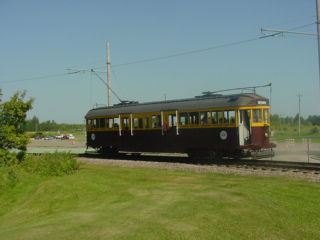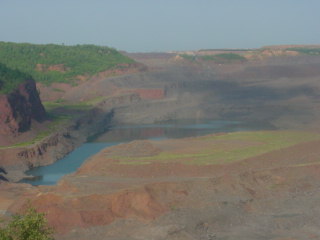
I arose and had breakfast at the Best Western before walking over to the Radisson and boarding the NRHS bus for my trip to the Missabe Iron Range which first took us to Hibbing.
A Brief HistoryIron was first found in Minnesota in 1863 and several explorers came to the area around Hibbing. Other engineers were dispatched to the area around Tower. The "Range", as it is called, stretches for over 100 miles from the area near Grand Rapids northeast through Virginia called the Missabe Range and into an area near Tower called the Vermillion Range. Some of the first samples had a very high iron content of 63-67 percent. The first rail shipment was from Tower to Two Harbors in 1884 and shipped out on a boat on Lake Superior. During the high days on the Iron Range, the railroads operated into the pits and the cars were loaded there by giant power shovels. Later, the ore was rolled into taconite pellets and shipped by rail to Lake Superior for loading onto boats for their trips throughout the Great Lakes.
The Greyhound Museum as seen from the bus. We there then taken to the Hull-Rust Mine Lookout outside of Hibbing.
Hull-Rust Mine History and FactsThe Hull Rust Mine, one of many that sprung up in the area, began mining operations in 1896. The village of Hibbing grew up near this mine pit - too near, in fact. In 1918, all buildings in the northern section of town were mounted on steel wheels and moved two miles to the south to make room for the mine’s expansion. The move took two years and cost $16 million to complete. 185 houses and 20 businesses were relocated and some of the larger buildings had to be cut in half during the process.
In 1901, the Oliver Iron Mining Division of U.S. Steel Corporation became the major operator of the Hull Rust Mine View. Today, Hibbing Taconite mines the area north, east and west of the Hull Rust Pit using shovels with a 41 cubic-yard capacity.
The combined Hull Rust Mahoning Mine and the Hibbing Taconite open pit covers 5,000 acres and the maximum length of the pit is 8 miles, east to west. The maximum width of the open pit is 3.5 miles, north to south. More than 1.4 billion tons of earth has been moved from the Hull Rust site, about the equivalent of digging a narrow tunnel from Minnesota through the center of the Earth and out the side!
The United States’ ability to prevail in World Wars I and II was greatly enhanced by Minnesota's iron ore reserves. Steel used in munitions and equipment was largely made possible by ore mined in northern Minnesota. More than 800 million tons of iron ore have been shipped from the Hull Rust Mahoning complex and at peak production in the 1940's, as much as one-quarter of the ore mined in the nation came from the Hull Rust pit. The Mahoning Mine was the region's first open pit mine, replacing the more dangerous underground mining methods. Most weeks around 11:00 AM, Hibbing Taconite fires a blast to break iron ore and rock.
The area’s very first mining lease was awarded to Frank Hibbing in 1891 and mining operations commenced a year later. Iron ore mining began in 1892 and the first iron ore shipments were made in 1895 from the Burt-Poole, Sellers & Mahoning Mines. Hibbing Taconite (HTC) began stripping operations in 1973 and began shipping iron ore pellets in 1977. Although named the Mahoning-Hull-Rust Mine, this large open pit actually consisted of over 30 separate mines both open pit and underground. In 1920, the Village of Hibbing was moved two miles south so that the underground mining operation could become open pit mining. Six blocks of Old North Hibbing became part of the mine.
After a brief talk about the mine by one of the employees, I debussed and made my way up the hill to the overlook tower.
Those buses looked so small compared to that open pit.
Views from the overlook tower.
The author and the Hull-Rust Mine behind. I walked down to the store for more pictures.
Looking up the hill at the Overlook Tower.
The Hull-Rust Open Pit Minem, after which I toured the grounds.
Mmining equipment all the way across the mine.
Looking down on the huge dump truck.
An old mine car.
One of the mine's engines for generating power.
One of the shovels.
Chris used for scale of size.
The historical sign.
Different size shovels.
Tires for a large dump truck.

More views of the Hull-Rust Mine.
The grounds at the mine. I went back to the bus and relaxed until everyone returned and we drove to our next stop in Chisholm.
Minnesota Museum of MiningThe Minnesota Museum of Mining gives visitors an opportunity to actually climb aboard equipment used to mine the Mesabi Range's rich iron ore. A castle built in 1933 out of stone is the entrance to this showcase of mining history. Climb aboard mining trucks, see a 1907 steam locomotive, or tour replicas of an underground mine and mining town.
Trucks displayed at the museum range from a 1930's White dump truck with a two-ton capacity to an oversized 120-ton WABCO Electrohaul. Imagine as you sit in the driver's seat becoming the operator of one of the fastest steam shovels ever made, a rare 1910 Atlantic Steam Shovel. Only six of these shovels were built and they were the prototype of the shovels used to dig the Panama Canal and remove the soil overburden on the Mesabi Range. View a working diorama of the Great North Railroad, created by F. Lee Jaques, or displays illustrating the lifestyle of the early Mesabi Range. Visitors can walk down into a simulated underground mine drift. Catch a glimpse of a steam-driven diamond drill still in working condition, or visit an authentic log cabin with Finnish sauna. The museum is a great place to experience life in the mining era.
>We arrived and were given a brief lecture about the museum.
Great North Road caboose C-55, nee Duluth Missabe and Iron Range C-55 built by the railroad in 1906 which made regular runs from the eastern Mesabi to Duluth ore docks and back, and is one of the very last DM&IR cabooses to remain in operation. The City of Biwabik gave the cabooseto the museum in April 1999, where it has been displayed beside the entry drive ever since.
Duluth, Missabe and Iron Range ore hopper 14954, builder and year unknown.
Duluth, Missabe and Iron Range ore hopper 14536, builder and year unknown.
Duluth, Missabe and Iron Range ore hopper 14613, builder and year unknown.
Burlington Northern wooden caboose 10990 1970, nee Great Northern X601 built by the railroad in 1925. It was donated to the museum in 1979.
Steam Shovel 120 E.
Hanna Mining Electric 60 ton steeple cab switcher 305 built by General Electric in 1928 for use at Hanna's Wabigon Mine at Buhl, Minnesota. It later worked at the Mesabi Chief Washing Plant line near Keewatin.
A dump truck.
An early road grader.
A comparison of dump truck sizes over the years.
The grounds.
Another form of mining equipment.
Two types of speeders.
Talk about steam shovels.
Diamond drill and equipment.
More mining equipment.
More shovels.
Mine drill.
Mine drill and ore rollers.
Steam mine drill.
Mine carts.
American Legion Drum and Bugle Corps bus.
Ore rollers.
Two Chisholm Minnesota tire trucks.
An 1896 Henry bicycle.
1916 White, the first Greyhound Bus.
Lumber was a major early industry in Minnesota.
The underground exhibit.
A mine core.
The main building of the Minnesota Mining Museum.
This building houses this made from scratch model railroad diorama created by artist-naturalist F. Lee Jacques.
A very nice model railroad. I returned to the bus and rested before we departed for our final stop of the tour, the Minnesota Discovery Center, formerly Ironworld, also in Chisholm.